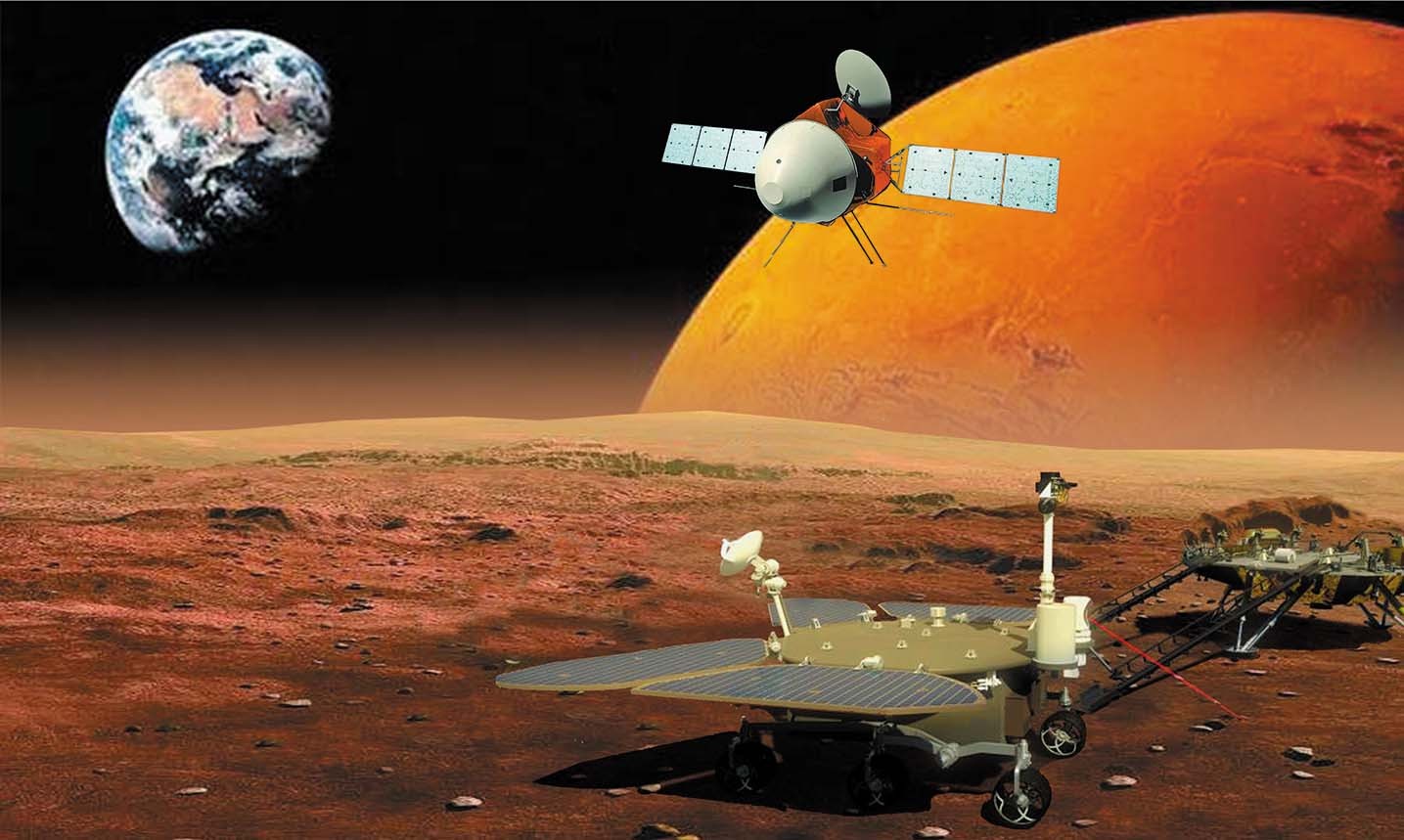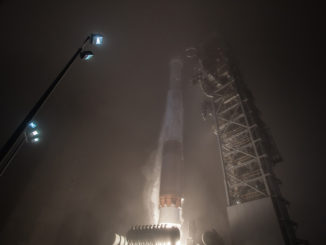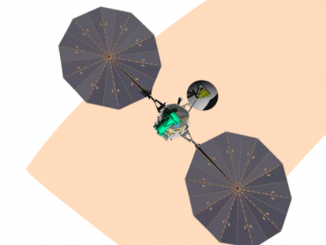EDITOR’S NOTE: Updated at 10 a.m. EDT (1400 GMT) with more details.

China’s space agency said Friday the country’s first Mars rover safely touched down and began sending data back to Earth, joining the United States as the only two nations to successfully land and operate a spacecraft on the surface of the Red Planet.
The Zhurong rover successfully descended to the Martian surface aboard a landing platform after a scorching atmospheric entry from a speed of nearly 11,000 mph (about 4.8 kilometers per second).
Landing occurred at 7:18 p.m. EDT (2318 GMT) Friday, according to the China National Space Administration.
China’s Tianwen 1 orbiter released the module containing the rover about three hours before landing, sending the capsule on a trajectory to dive into the Martian atmosphere about 77 miles (125 kilometers) above the planet. The entry capsule, protected by a thermal barrier, initially slowed to about 1,000 mph (460 meters per second) from the friction from Martian air molecules.
Following a landing profile similar to NASA’s Mars missions, the spacecraft deployed a supersonic parachute to continue slowing the lander’s velocity, Chine state media reported. The craft then jettisoned its parachute and heat shield, and used a retro-propulsion system to do the rest of the braking before touchdown on an expansive flat plain named Utopia Planitia in the northern hemisphere.
Chinese state media described the nine-minute entry, descent, and landing as the riskiest part of the Tianwen 1 mission — China’s first interplanetary explorer. Tianwen 1, consisting of an orbiter, lander, and rover, launched from Earth last July on China’s heavy-lift Long March 5 rocket.
“Each step had only one chance, and the actions were closely linked,” said Geng Yan, an official at the Lunar Exploration and Space Program Center of the CNSA, in a report published by China’s state-run Xinhua news agency. “If there had been any flaw, the landing would have failed.”
Tiawen 1 became the first Chinese mission to enter orbit around Mars when it arrived in February, making China the sixth country or space agency to have a probe orbiting the Red Planet, following the United States, the former Soviet Union, the European Space Agency, India, and the United Arab Emirates.
China jointed an even smaller international club with the Mars landing Friday. Only two nations previously achieved a soft landing on the Red Planet.
The Soviet Union’s Mars 3 lander was the first spacecraft to perform a soft landing on the Martian surface in December 1971, but the probe stopped transmitting about two minutes later.
Nine U.S. missions have successfully landed on Mars since 1976.
In a post on Chinese social media, CNSA said the Zhurong rover started sending telemetry back to Earth after landing on Mars, confirming the robot was alive after touchdown. It was not immediately clear when the first images from Zhurong will come back to Earth.
China did not announce the exact schedule for the landing attempt Friday, and there was no live television coverage of the event.
Thomas Zurbuchen, head of NASA’s science mission directorate, congratulated China on the landing of Zhurong rover.
“Congratulations to CNSA’s Tianwen 1 team for the successful landing of China’s first Mars exploration rover, Zhurong!” Zurbuchen tweeted. “Together with the global science community, I look forward to the important contributions this mission will make to humanity’s understanding of the Red Planet.”

If all goes according to plan, a 529-pound (240-kilogram) Zhurong rover will exit the landing platform down a ramp to begin driving around the unexplored landing site.
In an interview on Chinese state television, Wu Yanhua, CNSA’s vice administrator, said the Zhurong rover will depart its landing platform May 22. The lander and rover will take photos of each other May 27, Wu said.
Tianwen 1 arrived at Mars one day after the UAE’s Hope orbiter steered into orbit around the Red Planet, and eight days before landing of NASA’s Perseverance rover. The favorable planetary alignment of Earth and Mars that allowed the three missions to reach Mars in February comes once every 26 months.
Since arriving at Mars in February, the Tianwen 1 spacecraft maneuvered into an orbit closer to the planet to set up for deployment of the capsule containing the Zhurong rover.
Chinese officials announced the Zhurong as the name of the rover last month, naming the craft after the god of fire in ancient Chinese mythology.
The name Tianwen comes from the title of a poem written by the ancient Chinese poet Qu Yuan. Tianwen translates to Questions to Heaven.
The Tianwen 1 orbiter adjusted the low point of its elongated orbit to reach a collision course with Mars in the hours before the rover’s landing, according to amateur radio enthusiasts who track the trajectories of interplanetary space probes. Once ground teams confirm the orbiter is on a good trajectory, the carrier deployed the entry module and fired thrusters to re-establish a stable orbit around Mars.
Most Mars landers enter the Martian atmosphere on a direct course from Earth. Those trajectories typically have preset landing dates tied to when the missions launched. The design of the Tianwen 1 mission gave Chinese officials flexibility on when to schedule the landing.
The Tianwen 1 orbiter, which will continue its mission after releasing the lander and rover, is designed to operate for at least one Martian year, or about two years on Earth. The solar-powered rover, standing about 5.9 feet (1.8 meters) tall, has a life expectancy of at least 90 days, Chinese officials said.
In addition to mapping and survey duties, the orbiter will relay communications signals between ground controllers in China and the rover exploring the Martian surface.
With a successful landing accomplished, the rover will activate cameras, a subsurface radar to probe underground water ice, sensors to measure the composition of Martian rocks, a magnetic field monitor, and a weather station to begin collecting data at the Utopia Planitia location.

The Zhurong rover has six wheels, and sizes up slightly larger than NASA’s defunct Spirit and Opportunity rovers, which landed on the Red Planet in 2004. The Chinese craft is significantly smaller than NASA’s Curiosity and Perseverance rovers.
Wang Chi, director of the National Space Science Center at the Chinese Academy of Sciences, said in March that China is “open to international cooperation” and said data from the Tianwen 1 mission will be “available publicly soon.”
Scientists from the Institut de Recherche en Astrophysique et Planétologie, or IRAP, in France contributed to a Laser-Induced Breakdown Spectroscopy instrument on the Tianwen 1 rover.
French scientists, with support from the French space agency CNES, provided guidance to their Chinese counterparts on the spectroscopy technique, which uses a laser to zap a pinhead-size portion of a rock, and a spectrometer to analyze the light given off by plasma generated by the laser’s interaction with the rock’s surface.
The advanced technique allows an instrument to determine the chemical make-up of rocks on Mars. French scientists also provided China with a calibration target for the rover’s laser spectroscopy instrument.
The same French team worked on instruments on NASA’s Curiosity and Perseverance Mars rovers. The scientists hope to cross-calibrate measurements between the two U.S.-led missions and China’s Tianwen 1 rover.
Scientists from the Space Research Institute at the Austrian Academy of Sciences assisted in the development of the magnetometer on the Tianwen 1 orbiter and helped calibrate the flight instrument.
Argentina is home to a Chinese-owned deep space tracking antenna used to communicate with Tianwen 1. The European Space Agency also agreed to provide communications time for Tianwen 1 through its own worldwide network of deep space tracking stations.
Cooperation between NASA and China is restricted by a law that bars the U.S. space agency from nearly all bilateral engagement with the Chinese space program.
Email the author.
Follow Stephen Clark on Twitter: @StephenClark1.



